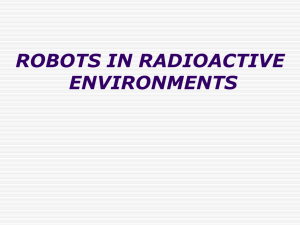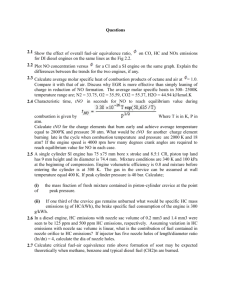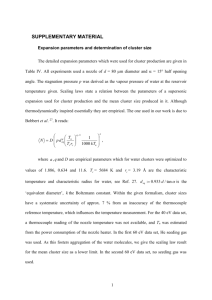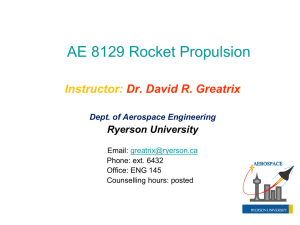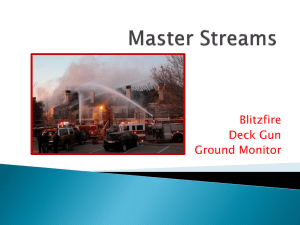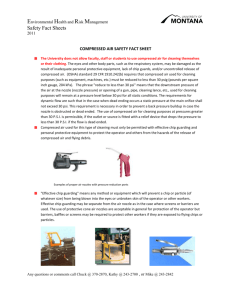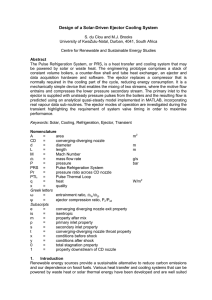Analysis And Simulation On A Passive Ejector For Improving
advertisement
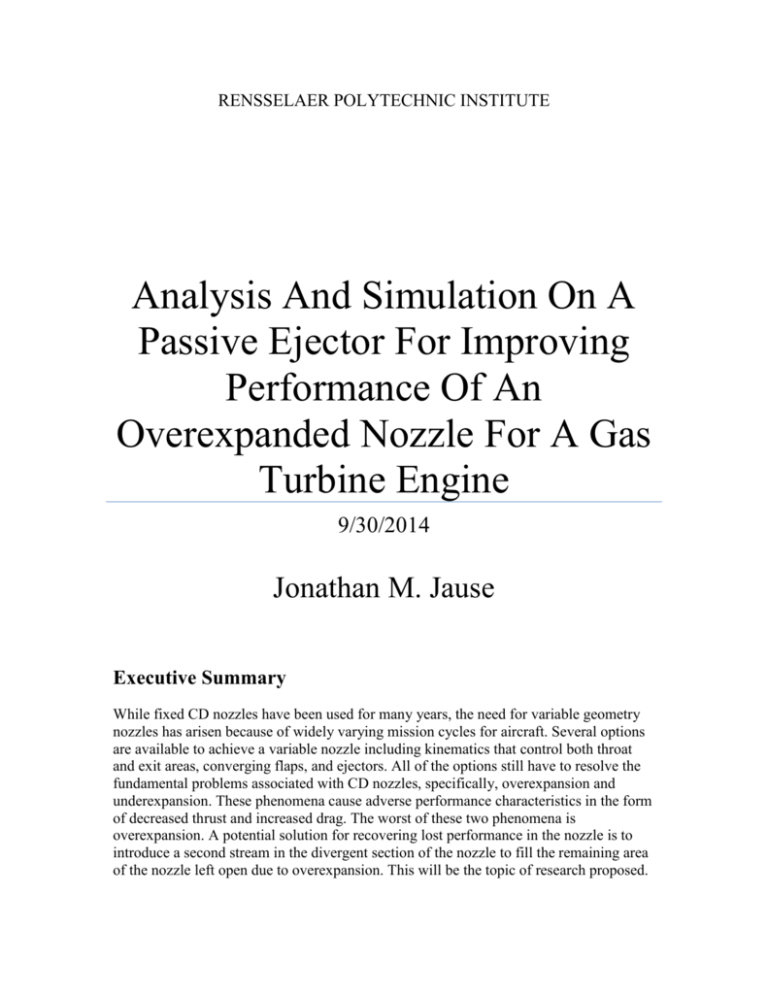
RENSSELAER POLYTECHNIC INSTITUTE Analysis And Simulation On A Passive Ejector For Improving Performance Of An Overexpanded Nozzle For A Gas Turbine Engine 9/30/2014 Jonathan M. Jause Executive Summary While fixed CD nozzles have been used for many years, the need for variable geometry nozzles has arisen because of widely varying mission cycles for aircraft. Several options are available to achieve a variable nozzle including kinematics that control both throat and exit areas, converging flaps, and ejectors. All of the options still have to resolve the fundamental problems associated with CD nozzles, specifically, overexpansion and underexpansion. These phenomena cause adverse performance characteristics in the form of decreased thrust and increased drag. The worst of these two phenomena is overexpansion. A potential solution for recovering lost performance in the nozzle is to introduce a second stream in the divergent section of the nozzle to fill the remaining area of the nozzle left open due to overexpansion. This will be the topic of research proposed. Introduction Most supersonic aircraft use afterburning for supersonic flight. But because they are also required to operate without afterburners the need for at least a two-position nozzle arises. This can be achieved in many different ways including the use of eyelid segments that close over a larger nozzle, or a nozzle the has actuation which allows for opening and closing of the throat, A8, and exit, A9, areas. Another feasible option and the one that will be the topic of research is the ejector. But first, design and overall considerations for nozzles must be discussed. Convergent-Divergent, CD, nozzles are used for supersonic aircraft because they can produce exit Mach numbers greater than 1. While it is necessary for the nozzle to perform ideally for optimal thrust, these nozzles can have overexpansion or underexpansion of the flow relative to the ambient conditions. In the case of underexpansion, the nozzle exit pressure is greater than the ambient pressure and, thus, a series alternating expansion fans to oblique shocks are formed in order for the exit pressure to be reduced to the ambient pressure. While this has adverse affects on performance it mostly comes in the form of loss of potential thrust. Similarly, overexpansion has a series of shocks emitting from the engine but in reverse order. Since exit pressure is less than ambient pressure, oblique shocks form at the exit and alternate to expansion fans until the exhaust gases completely mix and dissipate into the ambient air. Overexpansion has greater performance losses due to the increased drag associated with separation. Ejector nozzles follow a similar construction in that they form an effective convergent-divergent nozzle. However, they accomplish this a different way. Ejector nozzles are used in many supersonic aircraft because they can vary the throat area by use a secondary stream. A typical ejector nozzle design is shown in Figure 1. Primary air from the core of the engine flows through a convergent nozzle while a secondary airflow of higher pressure flows over the primary stream. The pressure provided by this secondary air is what controls the mass flow through the secondary nozzle thus controlling the nozzle area available to the primary airflow and, therefore, the nozzle expansion ratio. Figure 1. Schematic of 2 types of ejector nozzles in which the secondary airflow is used to vary the expansion ratio of the nozzle. If this nozzle expansion ratio is not ideal, the ejector nozzle will face similar performance affects to that of the CD nozzle through over and under expansion. Problem Description Underexpansion and overexpansion are on opposite sides of the spectrum when it comes to design options for improving performance of the nozzle. Increasing A9 will reduce the likelihood of underexpansion and regain the lost thrust potential. However, this will increase the risk of overexpansion and, hence, drag. Likewise, a reduction in A9 will reduce the risk of overexpansion while increasing the risk of underexpansion. An ejector nozzle is a potential option for improving the CD performance through a wider flight envelope. However, one requirement for the secondary airflow is to have a higher pressure than the primary air. The source of this high pressure air is the challenge of conventional ejectors. Most often, it is taken from the inlet where high static pressures are located as aircraft speed increases. This, however, requires increased inlet area, which in most cases of low observable requirements, is not an option. Another possible source could be bleeding air from one of the compressor stages although this will have a direct impact to engine performance and efficiency. It is the goal of this project to analytically and numerically propose potential solutions and trade studies as to the geometry and performance of a nozzle that reduces the impacts of overexpansion through the use of a passive ejector nozzle. The proposed design will consist of a 2 stream flow in which the primary stream flows through a nozzle and the secondary stream flows into the divergent section of the primary stream at a certain location. The location of this stream will depend on the required static pressure in order to flow the second stream and the difference between the ideal nozzle expansion pressure ratio and the overexpanded pressure ratio. Figure 2. Schematic of a passive ejector nozzle. Methodology/Approach Based upon previous methods and research conducted for similar projects (see references 1-3), the research will be conducted in a two-step approach. First, a series of baseline tests will be conducted on a typical CD nozzle looking at ideal, overexpanded, and underexpanded solutions. The results from these tests will then be compared to the 1D hand calculations for CFD calibration and correlation. The purpose of this is to validate the computational fluid dynamics modeling, meshing, boundary conditions, etc in order to establish confidence in the analysis tools. Once confidence has been achieved in the analysis tools, the second step will consist of conducting the passive ejector nozzle series of tests. A brief sensitivity study will be run testing different configurations of passive ejector geometries from which the best configuration will be used in a more detailed analysis of thrust and drag comparisons for ideal, overexpanded, and underexpanded cases. Variables in the sensitivity study will include location of the ejector in the divergent section of the nozzle, area of the ejector, and angle of the ejector. The suite of computational tools to be used for this analysis will be ANSYS Workbench version 14.5 and Fluent. Should these tools not adequately produce results, another possible option for conducting the analysis is COMSOL. This, however, should not be the case since ANSYS and Fluent are reliable and readily accessible tools. Several outcomes are expected from this analysis and simulation. 1. Correlation of conventional CD nozzle with ideal 1D analysis. 2. Developed equations for ideal 1D analysis of proposed design config. 3. Coefficient of Thrust vs varying ejector locations 4. Trade studies between ejector location and required secondary stream static pressure Milestones/Deadlines Based on the expected outcomes for this portion of the project, a schedule and expected deadlines have been established to meet the required deadline. This schedule is presented below. Deliverable Due Date Project Proposal 9/12/2014 Baseline Analysis for Correlation 10/3/2014 9/12/2014 Layout basic nozzle configuration 1D solution for CD nozzle Model, mesh, set up bc's and run analysis Post-process Correlate to 1D ideal solutions Passive Ejector Nozzle Analysis Develop 1D solution for passive ejector nozzle Develop model Refine meshing Set up boundary conditions Run analysis Iterate for different locations of ejector Post-process Final Draft Preliminary Final Report Final Report 9/15/2014 9/17/2014 9/18/2014 9/24/2014 10/3/2014 10/31/2014 10/6/2014 10/6/2014 10/8/2014 10/10/2014 10/15/2014 10/16/2014 10/20/2014 10/24/2014 10/31/2014 11/7/2014 11/28/2014 12/12/2014 Conclusions While fixed CD nozzles have been used for many years, the need for variable geometry nozzles has arisen because of widely varying mission cycles for aircraft. Several options are available to achieve a variable nozzle including kinematics that control both throat and exit areas, converging flaps, and ejectors. All of the options still have to resolve the fundamental problems associated with CD nozzles, specifically, overexpansion and underexpansion. These phenomena cause adverse performance characteristics in the form of decreased thrust and increased drag. The worst of these two phenomena is overexpansion. A potential solution for recovering lost performance in the nozzle is to introduce a second stream in the divergent section of the nozzle to fill the remaining area of the nozzle left open due to overexpansion. The research conducted in this project will provide detailed analysis of the geometry and configuration of the passive ejector nozzle to recover performance. Trade studies will be conducted on the location of the ejector in the nozzle and angle of the ejector as well as the required pressure at that location and each of their performance impacts. It is the intent of this project to establish generic trades on ejector location and sizing in order to be used in actual nozzle design. References (1) Gamble, E., Terrell, D., DeFrancesco, R. “Nozzle Selection and Design Criteria.” American Insitute of Aeronautics and Astronautics 2004 (2) Elements of Propulsion Gas Turbines and Rockets, J.D. Mattingly, 2006 (3) Aircraft Engines and Gas Turbines, Jack Kerrebrock (4) Aerospace Propulsion Systems, Thomas A. Ward, 2010 (5) Aerodynamics Aeronautics and Flight Mechanics, 2nd Edition, Barnes W. McCormick, 1995 (6) Chong, D. “Experimental and Numerical Analysis of Supersonic Air Ejector.” Applied Energy Journal 130 (2014) pgs 679-684. (7) Subramanian, G. “Comparison of Numerical and Experimental Investigations of Jet Ejector With Blower.” International Journal of Thermal Sciences 84 (2014) pgs 134-142. (8) Rao, S.M.V., “Novel Supersonic Nozzles For Mixing Enhancement in Supersonic Ejectors.” Applied Thermal Engineering Journal 71 (2014) pgs 62-71.
